
Beetles are insects that form the order Coleoptera, in the superorder Holometabola. Their front pair of wings are hardened into wing-cases, elytra, distinguishing them from most other insects. The Coleoptera, with about 400,000 described species, is the largest of all orders, constituting almost 40% of described insects and 25% of all known animal species; new species are discovered frequently, with estimates suggesting that there are between 0.9 and 2.1 million total species. Found in almost every habitat except the sea and the polar regions, they interact with their ecosystems in several ways: beetles often feed on plants and fungi, break down animal and plant debris, and eat other invertebrates. Some species are serious agricultural pests, such as the Colorado potato beetle, while others such as Coccinellidae eat aphids, scale insects, thrips, and other plant-sucking insects that damage crops. Some others also have unusual characteristics, such as fireflies, which use a light-emitting organ for mating and communication purposes.

The Adephaga are a suborder of beetles, and with more than 40,000 recorded species in 10 families, the second-largest of the four beetle suborders. Members of this suborder are collectively known as adephagans. The largest family is Carabidae which comprises most of the suborder with over 40,000 species. Adephaga also includes a variety of aquatic beetles, such as predaceous diving beetles and whirligig beetles.

Amphizoa is a genus of aquatic beetles in the suborder Adephaga, placed in its own monogeneric family, Amphizoidae. There are five known species of Amphizoa, three in western North America and two in the eastern Palearctic. They are sometimes referred to by the common name troutstream beetles.
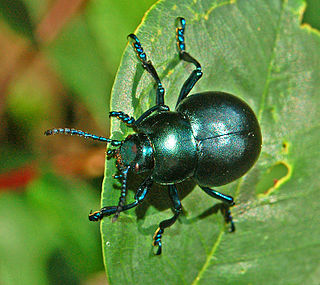
The bloody-nosed beetle, also called blood spewer or blood-spewing beetle, is a leaf beetle native to Europe.
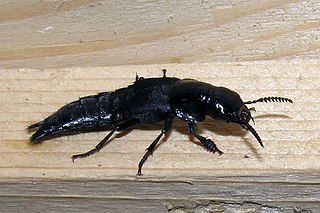
Velleius dilatatus, the hornet rove beetle, is a species of rove beetle belonging to the family Staphylinidae. This beetle is commensal with the European hornet, living in its nests.
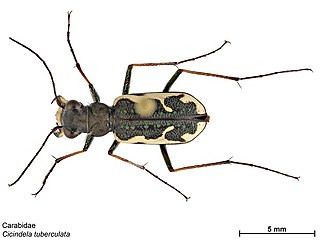
Neocicindela tuberculata is a species of tiger beetle in the family Cicindelidae, endemic to New Zealand. Its common names include common tiger beetle, moeone, and papapa, and in its larval stage penny doctor, butcher boy, kapuku, kui, kurikuri, moeone, and muremure. Neocicindela tuberculata was the first carabid beetle described from New Zealand. The species can run as fast as 5 miles per hour and are considered to be the fastest running beetles. Adult species prefer clay banks in summer and are good predators when in comes to insects.

Lilioceris merdigera is a species of beetle belonging to the family Chrysomelidae, subfamily Criocerinae.

Lebia grandis is a ground beetle in the family Carabidae found in North America. It is a specialist predator on the eggs and larvae of Colorado potato beetles, and its larvae are obligate parasitoids of Colorado potato beetle pupae.

Broscus cephalotes is a species of nocturnal, coastal ground beetle found throughout most of Europe. Its range spans from western Europe into western Siberia. The species was introduced recently in the eastern areas of Canada and has spread farther south and west into the United States. As a member of the family Carabidae, Broscus cephalotes is generally considered beneficial to humans due to its predatory habits. Their varied diet often includes crop pests and other small organisms.

Epomis is a subgenus of ground beetle genus Chlaenius. The larvae of this subgenus are notable for being obligate role-reversal predators. Amphibians such as frogs are normally predators of beetles; however, Epomis larvae feed exclusively on amphibians.
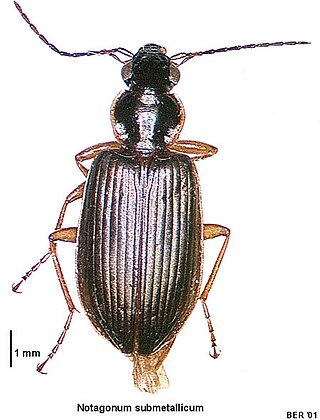
Notagonum submetallicum is a species of ground beetle in the subfamily Platyninae. It was described by Adam White in 1846.

Megadromus antarcticus, also known as the “Alexander beetle”, is a member of the Carabidae family and only found in the Canterbury region of New Zealand. Megadromus antarcticus are easily recognized by their iridescent green colouration.

Chlaenius dejeanii is a species of ground beetle native to the Palearctic and the Middle East. It is known from Bosnia and Herzegovina, Greece, Hungary, Israel, Italy, Russia, Syria, Turkey, and Ukraine.
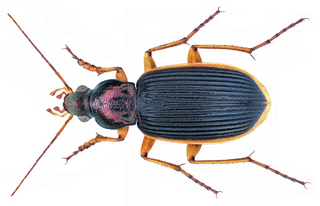
Chlaenius nigricans is a species of ground beetle native to the Palearctic. It is known from Borneo, China, India, Indonesia, Japan, Myanmar, North Korea, South Korea, Sri Lanka, and Taiwan.
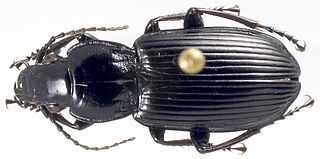
Pterostichus melanarius, the Rain Beetle, is a type of carabid of the genus Coleoptera. It is native to Europe but is increasingly found in North America after being introduced to the region in the 1920s. It is a predatory beetle that eats invertebrate pests, which makes it a valuable pest control agent in agricultural settings. Additionally, the beetle has wing dimorphism which has contributed to its increasing distribution across North America.

Sphaeroderma testaceum, the artichoke beetle, is a species of flea beetles in the family Chrysomelidae.

The Calleida viridipennis is a species of ground beetle belonging to the Carabidae family, and are referred to as carabid beetles. It is found in various states, including New York, New Mexico, Louisiana, and Florida. Habitat preferences include forests and swamps. C. virdipennis is a particular carabid beetle that is, on average, 10 mm long. Recognizable by a green-black metallic exoskeleton, it has a trapezoidal head shape. Its large eyes are also characteristic of the species. Below the exoskeleton reside functional wings, giving the beetle flight capacity.

Mecodema howitti, termed the Large Banks Peninsula ground beetle, is a carnivorous forest ground beetle in the genus Mecodema. It is endemic to Banks Peninsula, Canterbury, New Zealand, and is the largest of the 16 carabids found in the area.

Illeis cincta, is a species of lady beetle native to India, Sri Lanka and Indonesia.

Mecodema crenicolle is an endemic species of ground beetle from New Zealand.



















